Test XC-47: The best blue water cruiser of all time? Premiere at boot Düsseldorf
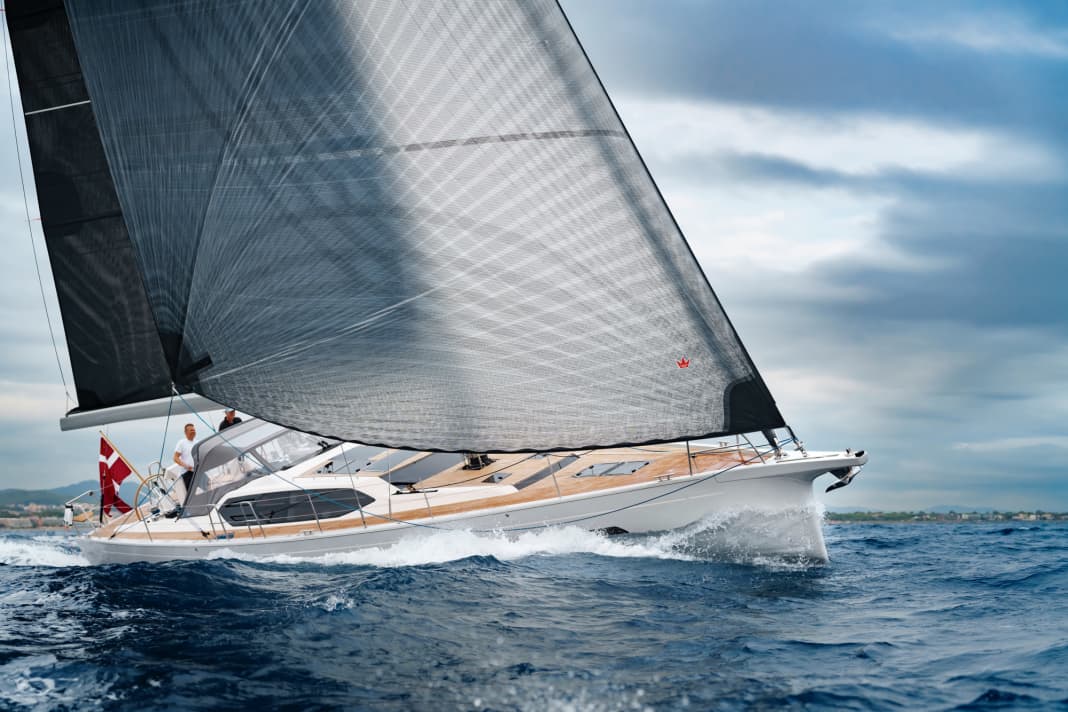





- The design of the XC-47 is well thought-out and ergonomic
- Running deck and coamings with plenty of space
- The XC-47 has a modern, timeless design
- Decent sailing performance thanks to top sails
- The XC-47 is practically unsinkable
- The XC-47 is packed with functional details
- Light-coloured interior despite oak wood
- Measured values XC-47
- YACHT rating XC-47
- Technical data XC-47
There are those moments that need no words or data and yet say a lot, if not almost everything, about a boat. On the XC-47 in mid-October off Port Ginesta, it is the cross against a confused mixture of swell and wind sea that reveals the essence of the new cruising yacht.
At 4, in gusts of 5 Beaufort, she is steadfastly chugging through the waves, her sturdy hull tilted to one side right up to the hexagonal windows. It is the kind of weather that elsewhere would make you think about the first reef, the next harbour, whether everything is carefully stowed and secured below deck. But the Dane conveys an indifference, as if nothing could ever disturb her almost meditative calm. She swings around her longitudinal axis with an almost tantalisingly light touch, and sails into the chaotic sea with the foredeck as smooth as butter. She parries gusts stoically, with a barely perceptible increase in position, without any nervousness. You can just let her go and let yourself go in the certainty that everything is fine.
The design of the XC-47 is well thought-out and ergonomic
That is indeed the case here, not only downwind, not only at sea. As soon as you cast off, you notice how well thought-out the design is, how ergonomic the deck layout is and how suitable the cockpit layout is for blue water. The XC-47 combines virtues that were often thought to be lost and adds a few new ones, making her look like the best companion who always thinks of everything and knows a solution for every problem - likeable, practical, good.
The lower shrouds are attached to the cabin superstructure on the inboard side, which involves a lot of extra work in terms of the structure and the extension, but allows an unobstructed passage forwards or aft. This is something you have to look for in series production.
The design of the aft cockpit is unusual, but simply impressive. It is at the same level as the running deck, which makes it possible to move quickly from one side to the other during harbour manoeuvres - a different kind of walk-around cockpit. In addition, the bench is so wide that it provides a comfortable berth at anchor.
The cockpit, which she closes off aft, does not pass for one of those open-air lounges that are en vogue today. Fortunately, it has to be said, because what looks casual often turns out to be exposed under sail and can seem downright imposing when the boat is under sail.
Running deck and coamings with plenty of space
X-Yachts, on the other hand, has created a very compact cockpit with a very wide running deck, even aft, and extra-wide coamings on which the lever clamps and winches are mounted. Thanks to the firmly bolted table, it offers plenty of security when seated, when changing places or when manoeuvring. There are ways to support or hold on at all relevant points. The slightly angled coamings are also perfect, making a longer stay here very pleasant.
For a shipyard that has earned its excellent reputation primarily through sporty yachts, the XC-47, which is consistently geared towards cruising, seems almost provocative.
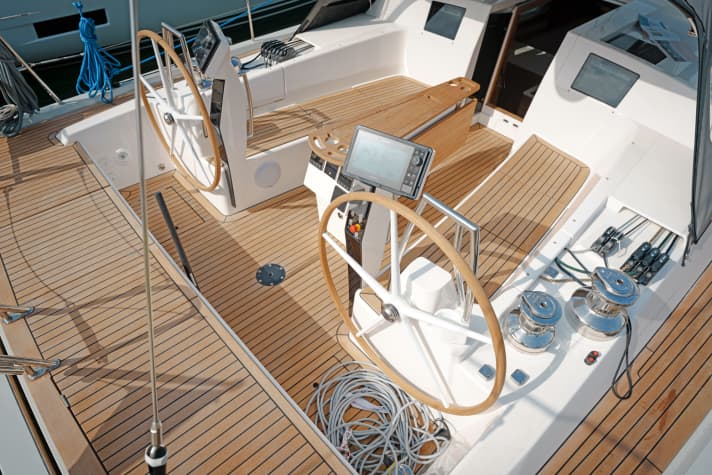
This is not X-Yachts' first foray into touring sailing. The Danes launched their first cruising model series 15 years ago with the initial XC-45, which was an instant success. However, in comparison, the older sisters appear almost staid and not nearly as sophisticated as the new edition now presented.
Development after owner survey and with 1:1 model
One reason for this is that the 47 is the product of an intensive dialogue with owners' wishes. A panel survey of dozens of XC customers provided the shipyard with important starting points for the in-house design team led by Thomas Mielec. And the developers not only listened carefully, they also studied their design more intensively than ever before.
A plywood model of the entire yacht, including the cockpit and the complete interior fittings, served as the first touchstone for the concept. And not just horizontally: The one-to-one mock-up could even be tilted 20 degrees to the side, a first in series yacht construction. According to Thomas Mielec, Director of Design and Engineering, this helped enormously in validating the plans. "We learnt more from the model than we had hoped for."
The XC-47 has a modern, timeless design
However, the XC-47 has not only departed from its predecessors in terms of function, but also form. It is much more independent in its lines, much less retro than the first XC generation, which deliberately sought a certain proximity to Hallberg-Rassy and co. Instead, the new model comes in a timelessly modern, pithy design. With the deck saloon superstructure, it also offers real added value, because it not only creates a considerable increase in width and volume below deck, but also visual axes in the harbour and at sea that did not yet exist at X-Yachts.
The windows have the shape of a flat hexagon, the sides of which form the halves of an "X" divided along its vertical axis. You may find this mannered, but it is a graphically successful reference to the history of the brand.
Twenty years ago, the X-43 used a similar quote, except that the stylised "X" was located between the Plexiglas surfaces of the narrow, two-part hull windows, not on their outer edges. The hexagonal shape that now characterises the ship also appears in many places. The handle holes of the lockers and drawers are milled out as hexagons, as are the inner panels of the hull windows. "X" everywhere.
Heavy and powerful, but still with plenty of temperament
Seen from the outside, the new boat takes a little getting used to. Her freeboard already protrudes far above the water; the impression is further emphasised by the high waterline. The closed stern and the large superstructure windows also give the XC-47 a powerful appearance. However, it conveys a kind of self-confident strength and competence that fits well with its character. In relation to the 23 metre high rig, she primarily appears powerful, but is quite elegant under sail.
The test boat displaces 15.6 tonnes due to very extensive equipment such as furling boom, bow and stern thruster, electric winches, generator, teak deck, watermaker and washing machine, around 1.1 tonnes more than an XC-47 in standard configuration. With a crew of six and at least half-full tanks, this adds another tonne. However, this hardly detracts from her temperament.
Decent sailing performance thanks to top sails
Even at a true wind speed of eight to ten knots, i.e. in a range where it gets tough on many cruising boats, the Dane logs between 6 and 6.5 knots at the cross with very good tacking angles of initially 90 degrees, later significantly less in a slightly freshening breeze. Very well-positioned sails made from Elvstrøm's Epex membrane and meticulous trimming are likely to have played a significant part in this. We have therefore included the price for such an upwind set in the calculation (see below).
The XC-47 finds the wind edge almost by itself and requires only the smallest corrections to the rudder. This gives a good feeling for the flow conditions on the low reaching profile. Jefa's steering is somewhat tight, which is not a problem in light winds, but requires noticeably more power on half-wind courses under Code Zero. A point that is on the shipyard's work list. The shipyard has now returned build number one to the jetty in Haderslev and intends to use the coming winter weeks for further tests and fine-tuning before build number two leaves the final assembly line.
As far as sheer speed is concerned, you can't expect miracles from a displacement boat with a moderately sporty sail carrying capacity of 4.6. The XC-47 barely exceeded its hull speed during the test run in gusts of 20 to 25 knots. However, with a waterline length of 13.17 metres, this is just under nine knots, which means a high basic speed on ocean passages. This means that daily passages of more than 200 nautical miles are no problem at all in the trade winds.
The XC-47 is practically unsinkable
The boat has pleasantly high reserves in terms of both rigidity and controllability. Almost 40 per cent ballast is well above average these days, especially as the large beam of 4.56 metres, which hardly decreases aft, also ensures dimensional stability. The rudder blade is designed in such a way that it warns you in good time if the boat is going to be hit by the sun before it becomes unavoidable. During the test, even wilful luffing under the 180 square metre gennaker in a good 15 knots of wind in gusts did not manage to get the XC-47 off track. She followed the rudder remarkably willingly on a half-wind course under Code Zero; at speeds of between 8.5 and 9.5 knots, steering was almost as much fun as on a performance cruiser of the same size.
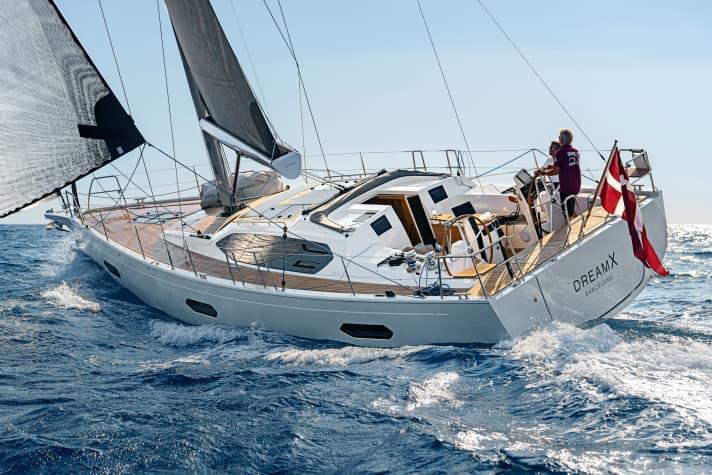
This feeling of precision is also thanks to the structural strength of the boat. Two collision bulkheads in the bow - the first for the anchor locker, the second for the more than man-high sail load - as well as a bulkhead in the stern that is watertight up to 50 centimetres above the waterline in the event of an accident make the XC-47 practically unsinkable.
As is usual with X-Yachts cruisers, the keel and rig are supported by a galvanised steel frame on which the boat can be craned using a central hot-drop, even without special gear. The hull shell is also stiffened with a composite floor assembly and locally reinforced with carbon fibre layers. It is laminated with epoxy resin rather than polyester resin and then annealed, which provides additional strength. As a result, it remains remarkably quiet below deck even with maximum load in the rig and rough seas: no twisting, no crackling, no creaking - which is quite extraordinary considering the immense storage space and the many lockers and cupboards.
The XC-47 is packed with functional details
In terms of substance, the XC-47 is a model of high-quality boat building. But Thomas Mielec and his colleagues did not stop there. On the contrary, they packed a whole host of highly functional solutions into this ship-like grab bag. To list them all would fill an evening or a good half of this issue, which is why we can only highlight a few special features here.
These include the fuel supply, for example. Ex works, the boat has two diesel tanks with a combined capacity of 500 litres. A third tank can be ordered as an option, providing a further 210 litres. Remarkably, even the standard version includes a day tank, which is deliberately narrow and high so that the fuel pump can reliably deliver fuel even when there is a lot of water. It holds 116 litres and can be filled from the main tanks at the touch of a button.
The construction of the floorboards is just as smart: their core is made of foam sandwich, which is light, does not warp and also insulates well. A frame made of marine plywood provides the strength, while a real wood veneer provides the feel and visual class. You have to love the XC-47 for this attention to detail alone.
Good ventilation - and even a glimpse of the sky
Even more sober-minded owners will be impressed by the accessibility of the storage compartments. Wherever possible, the shipyard has hinged the hatches and fitted them with gas pressure dampers so that, for example, the large compartments under the fore and aft berths are easily accessible. There are dedicated stowage compartments for the shelves, which are used to create a double berth from two single berths aft, and even accommodate the cushions. Someone really has thought of all eventualities.
This means that the guest compartments are not only ventilated via small deck and cockpit hatches, as is usually the case. Hidden under the standard teak panelling on both sides in the cockpit roofs is another opening that is barely noticeable from the outside, which not only lets in cool night air if required, but also provides a view of the sky.
The ventilation is very good in itself. There are no fewer than four large Lewmar hatches in the saloon, two of which open forwards and the two aft hatches to the sides, ensuring good circulation in almost all conditions. Two hatches concealed in the large deck saloon windows provide permanent ventilation; they can also remain open at sea or in driving rain. Air conditioning is therefore not absolutely necessary.
Light-coloured interior despite oak wood
The 14-metre cruiser offers plenty of space, comfort and class anyway. Criticism of the rampant coolness of modern yacht interiors is heard everywhere: It must fall silent here. The XC-47 has such a high proportion of the finest Northern European oak that it can almost be seen as the antithesis. If you wish, you can also choose partially lacquered surfaces or a white main bulkhead. However, there is no need for this, as the remarkable brightness below deck takes away any heaviness from the interior.
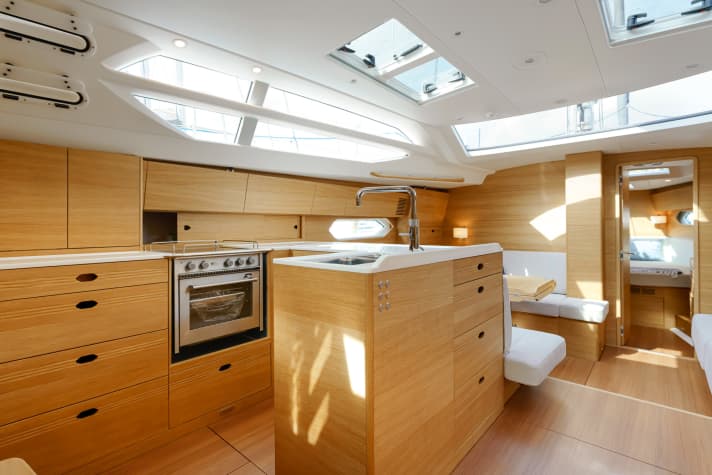
Great: In the saloon, there is an extra-deep and particularly lavishly upholstered sofa to starboard, which offers the reading and relaxation function of a good living room couch. And even the U-shaped seating area has a chaise longue. The two back cushions of the inward-facing legs can be flattened with a flick of the wrist.
It's extras like these that quickly make the boat more appealing. But they would be nothing if it lacked quality or finesse. The XC-47, however, has all of this, at the very highest level and in combination with a go-anywhere character that you don't find everywhere in the luxury class: It is the rare intersection of seaworthy blue water boat, enjoyable speed sailor and sturdy aluminium explorer.
Measured values XC-47
Sailing performance
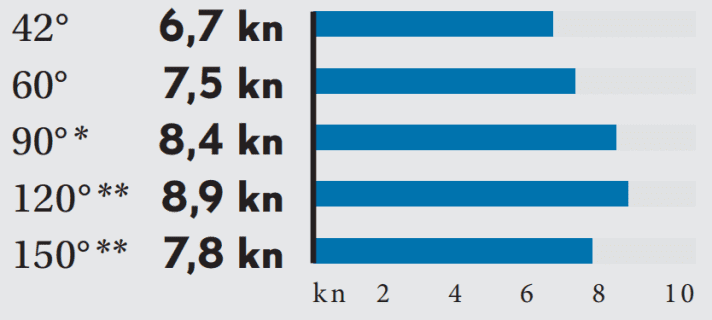
(without drift/current); wind speed: 9 to 12 kn (3-4 Bft), wave: approx. 0.4 m
* Code 0 ** Gennaker
Potential STZ* = 4.6

Appropriate sails for long journeys. With self-tacking jib instead of genoa, the sail carrying capacity is 4.4
* Dimensionless number. Calculation: 2√S/3√V. The higher the value, the more sail area (S) the ship has in relation to the displacement
YACHT rating XC-47
The XC-47 sets standards in many areas. There are other yachts for long sea voyages, but they are hardly more capable
Design and concept
- + Very solid construction
- + High structural safety
- + Fully designed for cruising
Sailing performance and trim
- + Spirited for tourers
- + Soft insertion into the sea
- - A little too heavy on the rudder
Living and finishing quality
- + Very good cabin layout throughout
- + Grandiose spatial impression
- + First-class workmanship and very high functionality
Equipment and technology
- + Immense storage space
- + High-quality components
Technical data XC-47
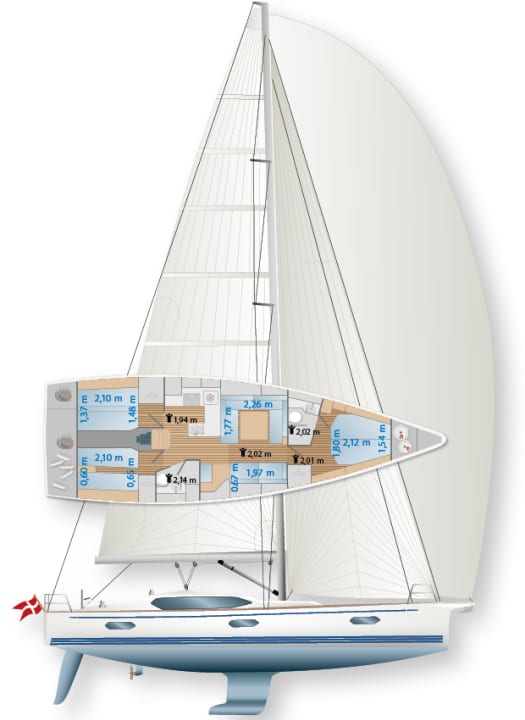
- CE design category: A
- Torso length: 14,30 m
- Total length: 15,21 m
- Waterline length: 13,17 m
- Width: 4,56 m
- Draught/alternative: 2,30/2,00 m
- Mast height above waterline: 23,00 m
- Theoretical torso speed: 8.8 kn
- Weight: 14,5 t
- Ballast/proportion: 5,5 t/38 %
- Mainsail: 68,0 m²
- Furling genoa (106 %): 55,4 m²
- machine (Yanmar): 59 kW/80 hp
- Fuel tanks (2): 500 l
- Fresh water tanks (2): 680 l
- Holding tanks (2): 100 l
Hull and deck construction
Fuselage as sandwich construction made of E-glass and epoxy laminated and tempered using the vacuum infusion process. Floor assembly with galvanised steel frame. Collision and main bulkhead made of GRP sandwich with carbon reinforcement; aft bulkhead watertight up to 50 cm above floating position after leakage. Deck foam sandwich, laminated by hand lay-up. Keel: Cast iron fin with hardened lead bulb; laminated with E-glass and moulded to the required dimensions
Sail
Not included as standard equipment on X-Yachts. Calculation below based on main and genoa. Useful extensions: rollable Code Zero (approx. €18,000) and gennaker with recovery tube (approx. €11,000)
Rig/reefing systems
An aluminium mast is standard on the test boat with furling boom for €46,350. A carbon fibre rig costs €124,360 extra
Equipment and prices
- Base price ex shipyard: 950.570 €
- Price ready to sail*: 1.007.630 €
- Comfort price*: 1.038.610 €
- Guarantee/against osmosis: 2/5 years
* How the prices shown are defined can be found here!
Shipyard
- X-Yachts A/S, 6100 Haderslev, Denmark, Mail: info@x-yachts.com, www.x-yachts.com
- Sales: X-Yachts Germany, Flensburg, Tel. 0461/43 02 09 90

